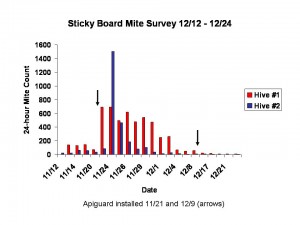Winter is quiet time for bees and their keepers. The thymol mite treatment is done, and as you can see below, the mite drop has tapered off dramatically. Not much more to do now but make some boxes in preparation for next year’s honey crop.
Although there is a general impression that bees hibernate through the winter, that is not so. Actually, bee metabolism speeds up as temperatures fall below 50 degrees F, and the queen begins to lay eggs again (albeit at a low rate) just after the winter solstice (December 21st).
Bees begin to ball up into a cluster within the hive when the ambient temperature falls below 64 degrees F, and the cluster compacts further to conserve heat as the temperature drops. If brood larvae are present, the colony will try to maintain the center of the cluster at about 93 degrees. The cluster consists of a tightly packed “crust” of bees with their heads pointed inward, surrounding a more loosely packed core of bees that generate heat by constricting their flight muscles. Basically, they survive by huddling together and shivering.
On the occasional warm winter day, bees will emerge to scout for food sources and to relieve themselves (a colony with thousands of members must have strict bathroom rules to prosper.) This might occur at ambient temperatures lower than 64 degrees for a hive in a sunny location. The more bees, the bigger the cluster and the easier it is to conserve heat. Small hives in northern climates can’t survive the cold, and northern beekeepers have been known to wrap their hives with insulation (or even store them in cellars) to help them make it through the winter. No such preparations are needed in Alabama, although a windbreak and some extra ventilation to prevent moisture buildup in the hive are prudent measures.
I removed the spacers from the hives to facilitate their forming a cluster, and I installed a top feeder on hive #1, which continues to eject an occasional dead bee with deformed wings. If they take the syrup, I might add one to the other hive, too. Feeders won’t help if it gets really cold, though – colonies can starve to death with honey stores as little as two inches from the cluster if it gets cold enough. The cluster has to be able to congregate directly over stored supplies in very cold weather, and it will move slowly sideways or upward (but never downward) to try to access more food as needed. The best preparation for winter is to have a populous hive with an adequate amount of stored honey (perhaps 30 pounds in South, three times that much in Canada) and pollen.

